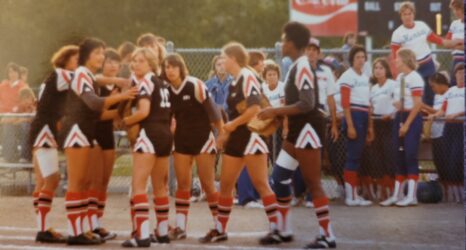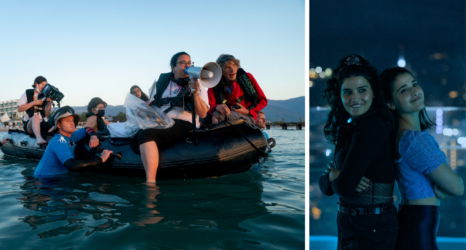The day the Olympics were over, I felt a small lump of sadness lodge in my belly. It was something more than the melancholy of late summer, that bittersweet mix of mourning and anticipation that a new school year often brings. No, this year the loss felt keener because for two weeks I became a sports fan, and I shared the experience with my children.
Usually it’s my mate who relaxes on the couch after dinner, watching the Red Sox, the Patriots or the Bruins in season (interspersed with Pro Surfing or the Tour de France). Our girls know all about Big Papi and Tom Brady. They understand the intricacies of baseball and football. They’ve seen the great heroes park a grand slam or throw a dazzling touchdown pass.
But this August found me couch-bound with my laptop, nestled between my two daughters, live-streaming Rio—and it was the women I wanted to watch.
Glorious female Olympic athletes, larger than life on the small screen, were competing at feats we could only imagine. I realized my girls had never seen women like this before: Warrior goddesses at the height of their powers. Even when petite, they were mighty.
We began with gymnastics, because my oldest (a budding gymnast at age 10) was obsessed with Team USA and the tumbling prowess of pint-sized Simone Biles, only 4’9” in her spangled leotard. Simone’s high-flying double layouts were indeed extraordinary, but I’ve always distrusted her sport’s emphasis on perfection and tininess. Frankly I was relieved when Simone won her fifth medal and we could move on to other arenas.
I wanted to see my events—the rowing and the running—not that I’d ever come close to the Olympics in my youth. I wanted to remember the exhilaration of handing off the baton in the 4 x 400 relay in high school, or racing in a fiberglass Eight in college, moving the boat with seven other women while our coxswain called out the rhythm. How my back swung in time with the rower in front of me: catch and drive, connect and pull, gliding over the water for 2000 meters of agony.
“Look how strong they are!” I marveled as we watched the US Women’s Eight—broad-shouldered powerhouses, most of them close to 6 feet—stroke cleanly down the course to claim gold. But my girls weren’t wild about the rowing, despite or perhaps because of their mother’s nostalgia for crew. Carmen—age 9 and a born risk-taker—wanted to cue up soccer instead and root for Hope Solo.
Each female in our household was claiming her own sporting identity—until track and field began and we could finally agree on what to watch.
Live-streaming Rio without commercials or interviews was a revelation that changed the Games for me. A few clicks and we were inside the Olympic Stadium, watching the sprinters step back into their starting blocks. I loved the pageantry of each race—the Lycra outfits, the jewelry and glitter, the glamorous hairstyles, and of course, the stunning muscular bodies. I savored the close-ups of the women’s faces—all focus and tension, energy barely restrained.
“I like her,” said Carmen as the camera paused on Jamaican sprinter Elaine Thompson, in a silver headband with long hair flowing down her back. “She’s pretty.”
“It doesn’t matter,” I said. “She’s fast.” I wanted my girls to abandon “pretty”— to find other heroines than Taylor Swift and her fashion-model friends, the flirty, lithe pop stars gyrating on YouTube. I thought about the tee-shirt I’d once seen on a circus acrobat: “STRONG IS THE NEW SKINNY.” That was the message I hoped they’d take away from these Olympics, no matter how far they went in their respective sports careers.
We watched strapping women hurl the shot put and discus, grunting and screaming in primal release. Unlike the gymnasts, there was nothing “nice,” “sweet,” or “well-behaved” about these athletes. To get to Rio, they’d all had to eschew conventional notions of femininity, become single-minded warriors in their own right. Maybe one benefit of sport is letting women be uncivilized. At the finish of the 4 x 100 meter relay, after her team edged out Jamaica for the gold, US runner Tianna Bartoletta uttered a wild victory cry, her face contorted in fierce jubilation. It didn’t matter if she was beautiful, if she was a wife or a mother (information the Olympic commentators find pertinent to a woman’s athletic career); in that moment, she was a conqueror.
Still, my youngest craved even more adrenaline. “That’s the sport I want to do, Mommy,” said Carmen, wide-eyed as we watched the pole vault, where tall badass woman sprinted full-speed down the runway as if charging into battle, carrying a long, carbon-fiber pole like a spear. The athletes had to slot the pole into a metal box in the ground, then hurtle their bodies up and over a nearly 5-meter high bar.
It was a fantastic sport—a combination of explosive power, gymnastic skill and pure courage—although back when I ran track, girls weren’t allowed to do it. I remember gawking with my friends as the coolest, bravest boys propelled themselves through the air, never imagining we’d have a chance to try. It wasn’t until 1996 that high school girls were permitted to pole vault, not until 1999 that females competed internationally. Women’s pole vault only became an Olympic event at the 2000 games in Sydney.
I narrated this feminist history for my daughters, enduring some eye-rolling at yet another maternal lecture. I persevered because I wanted them to know they could have a go at pole vaulting someday, that our flawed world kept changing in positive ways. The Olympics offered us plenty of opportunity for challenging lessons and questions. I was grateful my kids could watch remarkable athletes of color, living as we do in a homogeneous small town in the whitest state of the union. I was glad they watched woman after woman slay. It was a blessing to witness the peaceful goodwill of the Olympics—women and men of all cultures and colors competing and embracing, standing side by side on the podium.
In a time of fear and cynicism, it’s easy to feel powerless. But we could do this one thing—we could watch and hope, listen to the anthems, celebrate the warriors. In another four years (Tokyo 2020), my daughters probably won’t want to sit and watch with me. But we were here this time, together, on the couch. For two weeks, we were citizens of the world.





